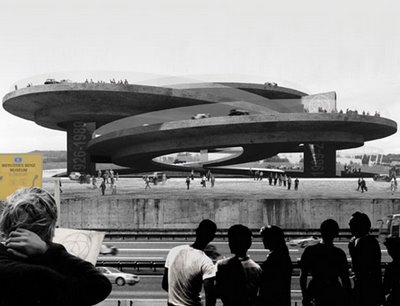
[Image: From the 2006 Venice Architecture Biennale].
The stated subject of this year's biennale is "the meta-city, an agglomeration that extends beyond the traditional form and concept of the city."
I'm not entirely sure what I'm supposed to be looking at up there – but I like what I want to see in that image, which is either a reclaimed assemblage of highway overpasses, or a house built to look like an assemblage of highway overpasses. Either way, it's genius.
Is it practical? Well, the ramps could be terraced, for starters, with floors at different levels, and steps cut into them, and toward the center of the cloverleaf could be a walled interior: bedrooms, bathrooms, a kitchen, guest rooms, all with floor to ceiling windows. A readymade, full-surround deck. Easy parking. Plumbing and electrics would come up through one of the concrete trunks – along with a staircase, through which to enter the house or visit your own backyard (or "underyard" – unless that's too Freudian).
It's the house of the future: built like a highway overpass. Built on a highway overpass.




[Images: From the Freeway series by Catherine Opie].
I suppose it's not even outside the realm of possibility to imagine, several hundred years from now, after nearly everyone's died of bird flu, AIDS, or open civil warfare, that freeways – those massive examples of widespread land use, the world over – could be reclaimed, domesticated, built upon as new foundations. Houses in the midst of highway flyovers, cloverleaf junctions given windows, bedrooms constructed on off-ramps. New feudal worlds of elevated flyovers, towns held aloft in the sky.
In Concrete Island by J.G. Ballard, we enter such a world, framed by drainage culverts, feeder roads, ascent ramps and storm tunnels, and we meet a man, called Maitland, who finds himself marooned after a crash, stuck alone in an urban blindspot: out of sight, out of mind, on an off-road island made entirely of concrete.
"In his aching head the concrete overpass and the system of motorways in which he was marooned had begun to assume an ever more threatening size. The illuminated route indicators rotated above his head, marked with meaningless destinations."
The man looks for "some circuitous route through the labyrinth of motorways" – but finds none. He simply sees "vast, empty parking lots laid down by the planners years before any tourist would arrive to park their cars, like a city abandoned in advance of itself."
Indeed, Maitland, our new Crusoe of the London motorways, is "alone in this forgotten world whose furthest shores were defined only by the roar of automobile engines... an alien planet abandoned by its inhabitants, a race of motorway builders who had long since vanished but had bequeathed to him this concrete wilderness."

In any case, as freeways continue to form the only visible horizon for urban inhabitants worldwide, we may realistically find that houses soon come to look like them: back-looping knots of elevated platforms, curved nests of ramps that are suitable for living in, elevated over an empty world we've left behind.
No comments:
Post a Comment